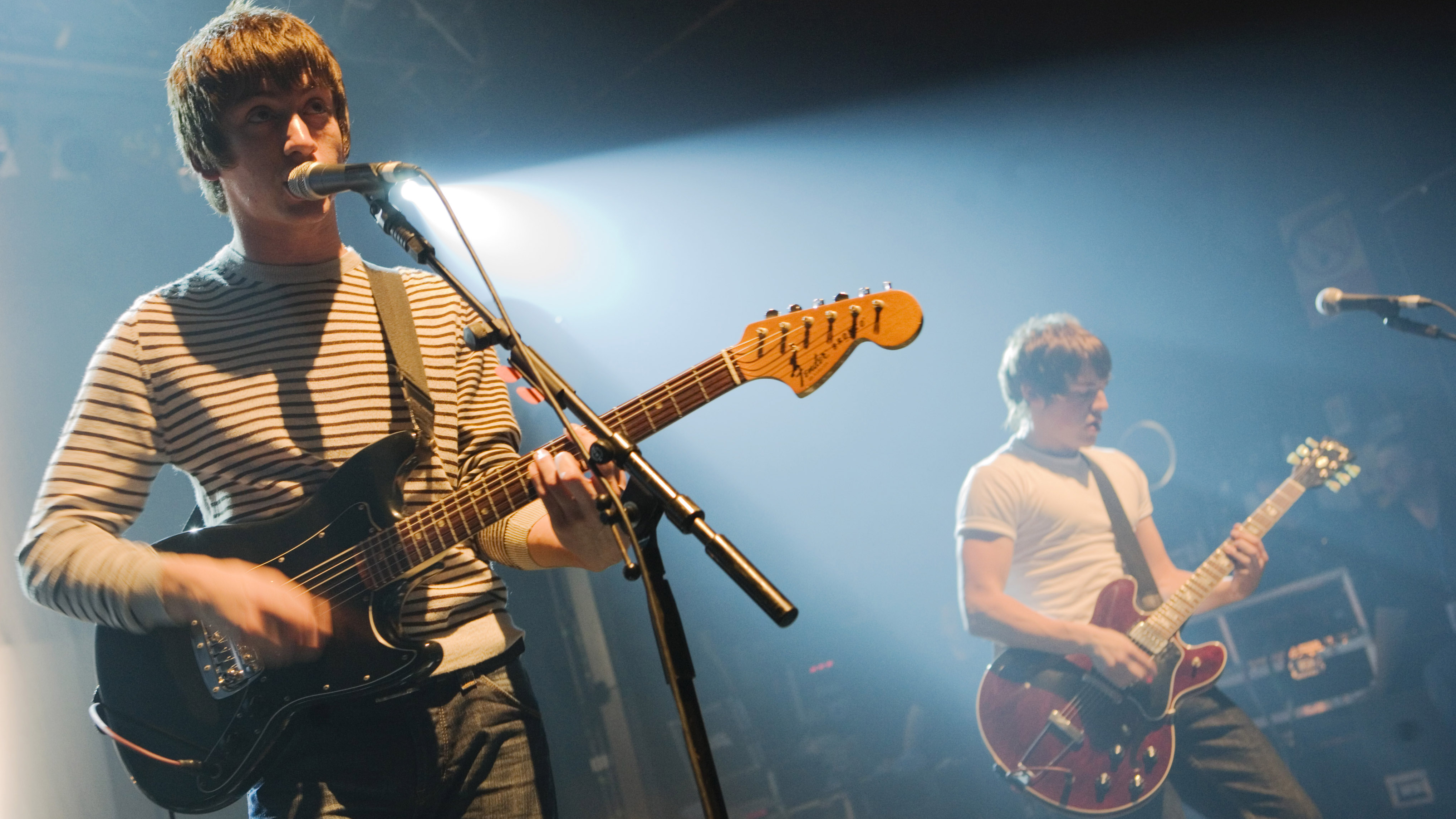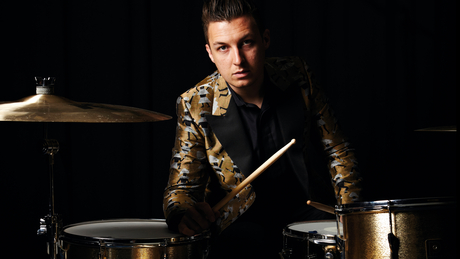5 songs guitarists need to hear by… Arctic Monkeys
Do you wanna know?

If you were asked to describe a typical Arctic Monkeys song, what would you say? Frenetic indie rock? Queens Of The Stone Age fuzz bangers? Jarvis Cocker wit? Drugged-out, falsetto psychedelics? We all think we know Arctic Monkeys, but it’s perhaps harder than ever to put a pin in the output of the four piece.
Over the last two decades they’ve grown and mutated. Each record shows a growth that makes sense against the context of the previous, but compare their frantic debut to the unhurried, weighty jams of their most recent work and the difference is stark. Here we take a look at five of the best guitar moments from their diverse back catalogue.
1. R U Mine? (AM, 2013)
2013’s AM was the sound of Arctic Monkeys planting two booted-feet in the rock world. A full on immersion into fuzz pedals, big riffs and – thanks, in part, to the influence of friend of the band Josh Homme – the scuzzy, shadier side of heavy music.

Lyrically, R U Mine? is a pop culture checklist, name-checking The Thunderbirds’ Tracy Island, The Lone Ranger and Nancy Sinatra/Lee Hazlewood hit Some Velvet Morning (“one of the strangest, druggiest, most darkly sexual songs ever written”, according to, er, The Telegraph). It is a baffled, angsty outpouring from an emotional protagonist who seems to be bombarding themselves with any distraction to fend off thoughts about the object of their affections.
The filthily, heavy glam-fuzz riff that powers the song feels beat Royal Blood’s debut album to the punch by a good year. It’s a heaving sea of a song and a fine class in dynamics – the key to all good riff writing. Note how they frequently halt the guitars in favour of sections of bass and vocal, or a cappella singing, which cleverly supercharge the main line when it returns to the fray.
2. I Bet You Look Good On The Dancefloor (Whatever People Say I Am, That's What I'm Not, 2006)
A world away from the insouciant psychedelia of the recent Tranquility Base Hotel & Casino, I Bet You Look Good On The Dancefloor was the song that brought the Arctic Monkeys careening into the 00s indie hive-mind. Amid a world that, at that point, primarily concerned itself with neon bandanas, nonsense gang vocals and singers playing floor toms for no good reason, it went off like a bomb.
At 2 minutes and 54 seconds, it felt like a dirty scrapper of a song, one that poked your eyes out and kicked you in the undercarriage before you’d raised your fists. It turned you over and legged it, before you’d figured out what had happened.
Want all the hottest music and gear news, reviews, deals, features and more, direct to your inbox? Sign up here.
The opening lead line hurtles up the neck like a surf lick on, well, lots of drugs, before it gets the (literal) bends and boozily meanders into Turner’s verse vocal. The jerking, muted chord sequences that so permeated tunes from that time are all over I Bet You Look Good… but here they stick in your ribs and give way to thrashing choruses.
The manic, grunge-y intro riff is so much fun that they bring it back as a sort of repurposed middle-eight after the second chorus, before the final raucous singalong.
3. Don’t Sit Down 'Cause I’ve Moved Your Chair (Suck It And See, 2011)
Suck It And See, Artic Monkey’s fourth album, arrived in 2011 and, while it received a pretty favourable set of reviews and sold well at the time, it has been somewhat forgotten about since, overshadowed by the raw beef of AM and the diverting experimentalism of Tranquility.

Arctic Monkeys – Don't Sit Down 'Cause I've Moved Your Chair
This is something of a shame, because while it is not as consistent as either of those two albums, you can nonetheless see the seeds of both directions being sown on Suck It And See.
Its tonal palette is rooted in the chiming guitars of 60s pop and rock, but there’s a real diversity among its 12 tracks. Don’t Sit Down Because I’ve Moved Your Chair is a guitar highlight – a swinging pentatonic riff that absolutely sets the blueprint for the dark, heavy sound they’d later fully embrace on AM, much to their success.
Here, the fuzz is blended with a cleaner retro rock tone, calling to mind 80s Matchbox B-Line Disaster’s psychotic proto-metal. It’s one of the most thundering and hypnotic riffs Turner and co have committed to record. It oozes menace and, at the close, gives way to one of the group’s most untapped, electrifying solos.
4. Arabella (AM, 2013)
Ask for another pick from the enduringly popular AM and many would choose the excellent Do I Wanna Know? However, we rate Arabella: the stomping chorus riff alternated with tapped hi-hat is pure Jimmy Page.
The guitar work is initially minimal. Barely perceptible in the verse, it’s all delayed and muted clean licks that skitter in and out of your peripheral vision, leaving the centre of the track dominated by Nick O’Malley and Matt Helders’ fat bass and drum combo. The chorus, though, dominates with the punctuating chordal stabs recalling Led Zeppelin’s Good Times, Bad Times, or Whole Lotta Love (the section that backs the solo, rather than the iconic verse riff).
Arctic Monkeys are masters of subverting these kind of ‘tribute’ hooks and they change the context with a falsetto vocal that is more akin to Pharrell Williams and N.E.R.D. At its close, it melts back into heavy rock territory channeling Tony Iommi with a warped, mid-y, fuzz solo.
5. One Point Perspective (Tranquility Base Hotel & Casino, 2018)
The band’s most recent album, 2018’s Tranquility Base Hotel & Casino, is a collection very much inspired by Alex Turner’s adopted home of LA. Written predominantly on the piano, the guitar takes a backseat for the vast majority of the record. However, there is a gleam of light towards the end of One Point Perspective, a song that is about the topics of drugged-out conversations at late night parties. “I’ll run for government, I’m gonna form a covers band,” he sings, recalling about 90% of musicians conversations involving substances. “Bear with me, man, I lost my train of thought…”
The band’s playing experience – and their increasing infatuations with glam rock, psychedelia and lounge music – really show in the understated arrangement and subtle, six-string licks that chime among the hip-hop-like grand piano stabs. There’s also one of Turner’s most tasteful solos in the middle-eight: a louche run of cracking fuzz, languid bends and surprising little slide notes.
Matt is a freelance journalist who has spent the last decade interviewing musicians for the likes of Total Guitar, Guitarist, Guitar World, MusicRadar, NME.com, DJ Mag and Electronic Sound. In 2020, he launched CreativeMoney.co.uk, which aims to share the ideas that make creative lifestyles more sustainable. He plays guitar, but should not be allowed near your delay pedals.
